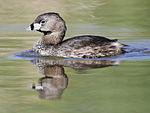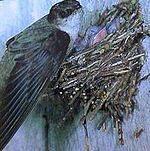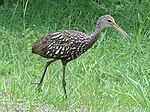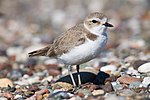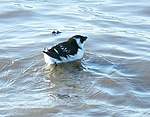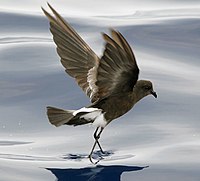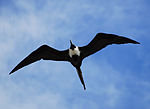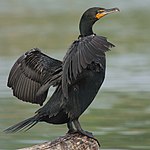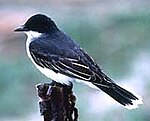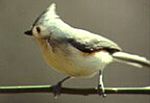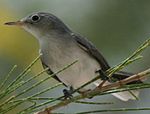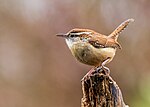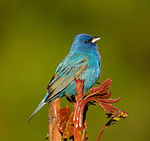List of birds of Georgia (U.S. state)
Unless otherwise noted, all species listed below are considered to occur regularly in Georgia as permanent residents, summer or winter visitors, or migrants.
These are birds that are adapted for an aquatic existence with webbed feet, bills that are flattened to a greater or lesser extent, and feathers that are excellent at shedding water due to special oils.
Order: Apodiformes Family: Trochilidae Hummingbirds are small birds capable of hovering in mid-air due to the rapid flapping of their wings.
The most typical family members occupy dense vegetation in damp environments near lakes, swamps, or rivers.
Order: Gruiformes Family: Aramidae The limpkin is an odd bird that looks like a large rail, but is skeletally closer to the cranes.
Order: Charadriiformes Family: Haematopodidae The oystercatchers are large, conspicuous, and noisy plover-like birds, with strong bills used for smashing or prising open molluscs.
They are small to medium-sized birds with compact bodies, short thick necks, and long, usually pointed, wings.
Different lengths of legs and bills enable multiple species to feed in the same habitat, particularly on the coast, without direct competition for food.
Order: Charadriiformes Family: Stercorariidae Skuas and jaegers are medium to large seabirds, typically with gray or brown plumage, often with white markings on the wings.
Order: Phaethontiformes Family: Phaethontidae Tropicbirds are slender white birds of tropical oceans with exceptionally long central tail feathers.
Order: Gaviiformes Family: Gaviidae Loons are aquatic birds the size of a large duck, to which they are unrelated.
With mostly black plumage and spear-shaped bills, loons swim well and fly adequately, but because their legs are placed towards the rear of the body, are clumsy on land.
Order: Procellariiformes Family: Oceanitidae The storm-petrels are the smallest seabirds, relatives of the petrels, feeding on planktonic crustaceans and small fish picked from the surface, typically while hovering.
Order: Procellariiformes Family: Procellariidae The procellariids are the main group of medium-sized "true petrels", characterized by united tubular nostrils with a median septum.
Order: Ciconiiformes Family: Ciconiidae Storks are large, heavy, long-legged, long-necked wading birds with long stout bills and wide wingspans.
Order: Suliformes Family: Phalacrocoracidae Cormorants are medium-to-large aquatic birds, usually with mainly dark plumage and areas of colored skin on the face.
Order: Pelecaniformes Family: Pelecanidae Pelicans are very large water birds with a distinctive pouch under their beak.
They have very large, hooked beaks for tearing flesh from their prey, strong legs, powerful talons, and keen eyesight.
Order: Strigiformes Family: Strigidae Typical owls are small to large solitary nocturnal birds of prey.
Order: Coraciiformes Family: Alcedinidae Kingfishers are medium-sized birds with large heads, long pointed bills, short legs, and stubby tails.
Order: Piciformes Family: Picidae Woodpeckers are small to medium-sized birds with chisel-like beaks, short legs, stiff tails, and long tongues used for capturing insects.
Order: Passeriformes Family: Tyrannidae Tyrant flycatchers are passerines which occur throughout North and South America.
Order: Passeriformes Family: Laniidae Shrikes are passerines known for their habit of catching other birds and small animals and impaling the uneaten portions of their bodies on thorns.
Order: Passeriformes Family: Alaudidae Larks are small terrestrial birds with often extravagant songs and display flights.
Order: Passeriformes Family: Bombycillidae The waxwings are a group of passerine birds with soft silky plumage and unique red tips to some of the wing feathers.
Order: Passeriformes Family: Troglodytidae Wrens are small and inconspicuous birds, except for their loud songs.
They are notable for their vocalization, especially their remarkable ability to mimic a wide variety of birds and other sounds heard outdoors.
Order: Passeriformes Family: Turdidae The thrushes are a group of passerine birds that occur mainly but not exclusively in the Old World.
Order: Passeriformes Family: Passeridae Old World sparrows, also known sometimes as weaver finches, are small passerine birds.
Order: Passeriformes Family: Icteriidae This species was historically placed in the wood-warblers (Parulidae) but nonetheless most authorities were unsure if it belonged there.







